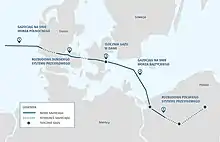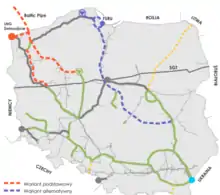Baltic Pipe
The Baltic Pipe is under construction natural gas pipeline between the Norwegian sector of the North Sea and Poland. It is a strategic infrastructure project to create a new gas supply corridor. When completed in October 2022, it will transport natural gas from the North Sea to Poland via Denmark. The project is being developed by the Danish gas and electricity transmission system operator Energinet and the Polish gas transmission system operator Gaz-System.[1][2] The project is recognised as a project of common interest of the European Union.[3][1]
| Baltic Pipe | |
|---|---|
 | |
| Location | |
| Country | Norway Denmark Poland |
| From | Europipe II, North Sea |
| Passes through | North Sea Denmark Baltic Sea |
| To | Poland |
| General information | |
| Type | natural gas |
| Operator | Energinet Gaz-System |
| Technical information | |
| Maximum discharge | 10×109 m3/a (350×109 cu ft/a) (Norway–Denmark–Poland) 3×109 m3/a (110×109 cu ft/a) (Poland–Denmark) |


History
The project started in 2001, when Danish oil and gas company DONG and Polish oil and gas company PGNiG signed an agreement on construction of the pipeline and Danish gas supply to Poland.[4] It was agreed to establish a pipeline consortium with two-thirds of the shares belonging to DONG and one-third to PGNiG with possible Statoil participation.[5] However, shortly afterward the project was suspended, because of economic feasibility.
The project was revived in 2007. On 2 May 2007, PGNiG and Energinet, a Danish transmission system operator, which was taken over Danish natural gas transmission network from DONG, signed an agreement to explore the possibility of construction the Baltic Pipe.[6] In August 2008, the Polish Government replaced PGNiG with the fully state-owned pipeline operator Gaz-System as the project partner.[7]
On 18 May 2009, the European Commission launched a call for proposals for grants in the framework of the European Energy Programme for Recovery. It proposed to allocate about €150 million for implementation of Skanled and Baltic Pipe projects.[8] The European Commission provided €3.2 million for technical design of the pipeline.[9][10] However, on 16 June 2009 Gaz-System suspended the implementation of the project due to suspension of the Skanled project and lack of natural gas demand in Poland.[11] The project was reactivated by Poland in February 2010 after reviewing the project,[12] to reduce its use of coal and eastern gas.[13]
The current project was initiated in 2016 when a new feasibility study was conducted.[1] The project was included in the first list of projects of common interest by the European Commission in 2013, and the binding list on 18 November 2015. On 24 November 2017, it was included for the third time.[14] In mid-2017, Energinet and Gaz-System launched the open season procedure.[2][15] In January 2018, they signed 15-year capacity agreements with market participants. In 2018, public hearings took place in Denmark, Sweden, Germany and Poland. In July 2018, a €18.3 million subsidy was granted from the Connecting Europe Facility.[14] In April 2019, €214.9 million funding was granted to the project by the European Commission.[16]
In 2018-2020, the analytical, survey and design works are being carried out in order to obtain the required permits for construction and operation of the Baltic offshore pipeline.
In 2018, 48% of electricity produced in Poland came from hard coal, 29% from brown coal, 13% from renewable sources (mostly wind power) and 7% from natural gas.[17]
Technical features
The original 275-kilometre (171 mi) submarine pipeline was to connect Faxe South in Denmark and Niechorze-Pogorzelica in Poland. The cost of building that pipeline was estimated at €335-350 million, depending on the diameter of the pipe.[5] It was planned to be built allowing gas flows in both directions.[6]
The current project consists of five major segments:
- The North Sea offshore pipeline – An offshore pipeline between the Norwegian gas system in the North Sea and the Danish gas transmission system. It will be tie-in to Europipe II, which connects Norway and Germany. Its landfall will be on the west coast of Denmark near Blaabjerg. The offshore pipeline will be built and operated by Energinet.
- Onshore Denmark – expansion of the existing Danish transmission system from West to East, including 200 kilometres (120 mi) of new pipelines. The planned expansions in Denmark include construction of a new pipeline from Blaabjerg to Nybro, construction of a receiving plant at Nybro, construction of a new pipeline from Egtved to the Little Belt, construction of a new pipeline across the Little Belt, construction of a new pipeline over Fyn from the Little Belt to Nyborg, construction of a new pipeline on Zealand from Kongsmark to the Baltic Sea offshore landfall at the southeaster part of Zealand. It will be built and operated by Energinet.
- A compressor station in Denmark located on the eastern part of Zealand, which is necessary for the pipeline between Denmark and Poland. It will also ensure the reverse flow. It will be built and operated by Energinet, and it is co-financed by Gaz-System.
- The Baltic Sea offshore pipeline of 275 kilometres (171 mi) between Denmark and Poland providing bi-directional transmission of gas. The route goes through the Danish and Polish maritime areas and Swedish exclusive economic zone with the preferred landfalls in Faxe South Denmark and in Niechorze–Pogorzelica in Poland. The offshore pipeline will be built and operated by Gaz-System.
- Onshore Poland – expansion of the Polish gas transmission system, including 230 to 340 kilometres (140 to 210 mi) new pipeline and three gas compressor stations. It consists of construction of the onshore gas pipeline connecting the offshore gas pipeline to the national transmission system, construction of the Goleniów–Lwówek pipeline, extension of the Goleniów gas compressor station, construction of the Gustorzyn gas compressor station, and extension of the Odolanów gas compressor station. It will be built and operated by Gaz-System.
It will have gas transportation capacity of 10 billion cubic metres per annum (350 billion cubic feet per annum) from Norway to Denmark and Poland, and 3 billion cubic metres per annum (110 billion cubic feet per annum) from Poland to Denmark.[18] The pipeline from the North Sea to Poland is expected to have a total length of 800–950 kilometres (500–590 mi).
References
- "The pipe dream securing EU energy security". Pipeline International. 2019-05-25. Retrieved 2019-07-03.
- "The Baltic Pipe Project moves to the next level". CEEP. 2017-07-27. Retrieved 2019-07-03.
- Morgan, Sam (2019-06-27). "Baltic power games in the ascendancy". Euractiv. Retrieved 2019-07-03.
- "Scandinavian Gas Headed for Poland". Warsaw Voice. 2001-07-08. Retrieved 2007-09-15.
- "One Step Closer to Diversification". Warsaw Voice. 2001-06-24. Retrieved 2007-09-15.
- Valentin, Bente T. (2007-05-02). "Denmark and Poland look into gas pipeline" (Press release). Energinet. Archived from the original on 2007-06-30. Retrieved 2007-09-15.
- "PGNiG eyes Norway booster". Upstream Online. NHST Media Group. 2008-08-28. Retrieved 2009-10-14.
- "The Commission calls for proposals for €4 billion worth of energy investments" (Press release). European Commission. 2009-05-18. Retrieved 2010-02-21.
- "Gaz-System pracuje nad projektem technicznym Baltic Pipe" [Gaz-System is working on the technical design of the Baltic Pipe]. wnp.pl (in Polish). PAP. 2009-09-24. Retrieved 2010-02-21.
- "Gaz-System pracuje nad projektem technicznym Baltic Pipe" [Gaz-System is working on the technical design Baltic Pipe]. wnp.pl (in Polish). PAP. 2009-09-24. Retrieved 2010-02-21.
- Szczepański, Marcin (2009-12-23). "BBN o wstrzymaniu prac nad projektem Baltic Pipe" [BNS to suspend work on the Baltic Pipe project]. wnp.pl (in Polish). Retrieved 2010-02-21.
- Szczepański, Marcin (2010-02-11). "Gaz-System: prace nad Baltic Pipe mogą ruszyć w drugiej połowie 2011 roku" [Gaz-System: Work on the Baltic Pipe can be launched in the second half of 2011]. wnp.pl (in Polish). Retrieved 2010-02-21.
- Shotter, James (9 June 2020). "Polish gas network close to fully financing Baltic Pipe to Norway". www.ft.com. Archived from the original on 22 July 2020.
As well as allowing Poland to diversify its gas supplies, the Baltic Pipe will help it decarbonise its economy. Poland derives almost 80 per cent of its electricity from coal
- "EU grants another subsidy to Baltic Pipe under the CEF 2018". Biznes Alert. 2018-07-20. Retrieved 2019-07-03.
- "Gaz-System: Market is interested in Baltic Pipe". Biznes Alert. 2017-07-27. Retrieved 2019-07-03.
- Shrestha, Priyanka (2019-04-15). "Poland's Baltic Pipe pumped up with €215m EU grant". Energy Live News. Retrieved 2019-07-03.
- "Energy statistics in 2017 and 2018" (PDF). Archived (PDF) from the original on 23 February 2020. Retrieved 2020-03-18.
- Woellwarth, Lydia (2019-06-25). "Baltic Pipe infrastructure location decision made". World Pipelines. Retrieved 2019-07-03.